Airspace Contamination by Volcanic Ash from Sequences of Etna Paroxysms: Coupling the WRF-Chem Dispersion Model with Near-Source L-Band Radar Observations
Abstract
1. Introduction
1.1. Volcanic Ash Hazards in Aviation
1.2. Volcanic Ash Advisories on Etna
1.3. Improving Ash Dispersal Modelling: Coupling WRF-Chem and Time-Varying Eruption Source Parameters
2. Materials and Methods
2.1. Description of the Two Eruptive Sequences
2.1.1. The 2013 Sequence: 26 October to 2 December
| 2013 | Julian Day | Start (UTC) | End (UTC) | Duration | Bins | V2B MER (kg s−1) | VEI | VAA | |
|---|---|---|---|---|---|---|---|---|---|
| Paroxysm | Date | Start | HH:MM | HH:MM | HH:MM | Range in m (Bin Number) | Average (Max) | ||
| NSE1 | 26 October | 299 | 01:35 | 10:27 | 08:52 | 3135–3285 (3; 4) | 2.9 × 104 (2.1 × 105) | 2 | 7 |
| NSE2 | 11 November | 315 | 00:01 | 11:52 | 11:51 | 3135–3285 (3; 4) | 3.6 × 104 (2.3 × 105) | 2 | 2 |
| NSE3 | 16–17 November | 320–321 | 22:14 (16/11) | 04:35 (17/11) | 05:21 | 3135–3285 (3; 4) | 4.3 × 104 (2.8 × 105) | nd | 4 |
| NSE4 | 23 November | 327 | 07:13 | 10:26 | 03:13 | 3135–3285 (3; 4) | 3.9 × 105 (8.9 × 106) | 2 | 4 |
| NSE5 | 28 November | 332 | 15:15 | 23:35 | 08:20 | 3135–3285 (3; 4) | 2.5 × 105 (1.3 × 106) | nd | 3 |
| NSE6 | 2 December | 336 | 19:08 | 22:42 | 03:34 | 3135–3285 (3; 4) | 2.5 × 105 (1.8 × 106) | 2 | 2 |
2.1.2. The 2015 Sequence: 3–5 December
| 2015 | Julian Day | Start (UTC) | End (UTC) | Duration | Bins | V2B MER (kg s−1) | VEI | VAA | |
|---|---|---|---|---|---|---|---|---|---|
| Paroxysm | Date | Start | HH:MM | HH:MM | HH:MM | Range in m (Bin Number) | Aver (Max) | ||
| VOR1 | 3 December | 336 | 02:00 | 03:31 | 01:31 | 3885–4185 (8; 9; 10) | 1.7 × 106 (4.5 × 106) | 2 | 5 |
| VOR2 | 4 December | 337 | 09:03 | 10:14 | 01:11 | 3735–4035 (7; 8; 9) | 1.7 × 105 (5.0 × 105) | nd | 3 |
| VOR3 | 4 December | 337 | 20:26 | 21:15 | 00:49 | 3735–4035 (7; 8; 9) | 1.8 × 105 (1.2 × 106) | nd | 2 |
| VOR4 | 5 December | 338 | 14:45 | 16:10 | 01:25 | 3735–4035 (7; 8; 9) | 1.0 × 105 (4.1 × 105) | nd | 4 |
2.2. The VOLDORAD-2B (V2B) Doppler Radar System
2.2.1. Description
2.2.2. Data Elaboration

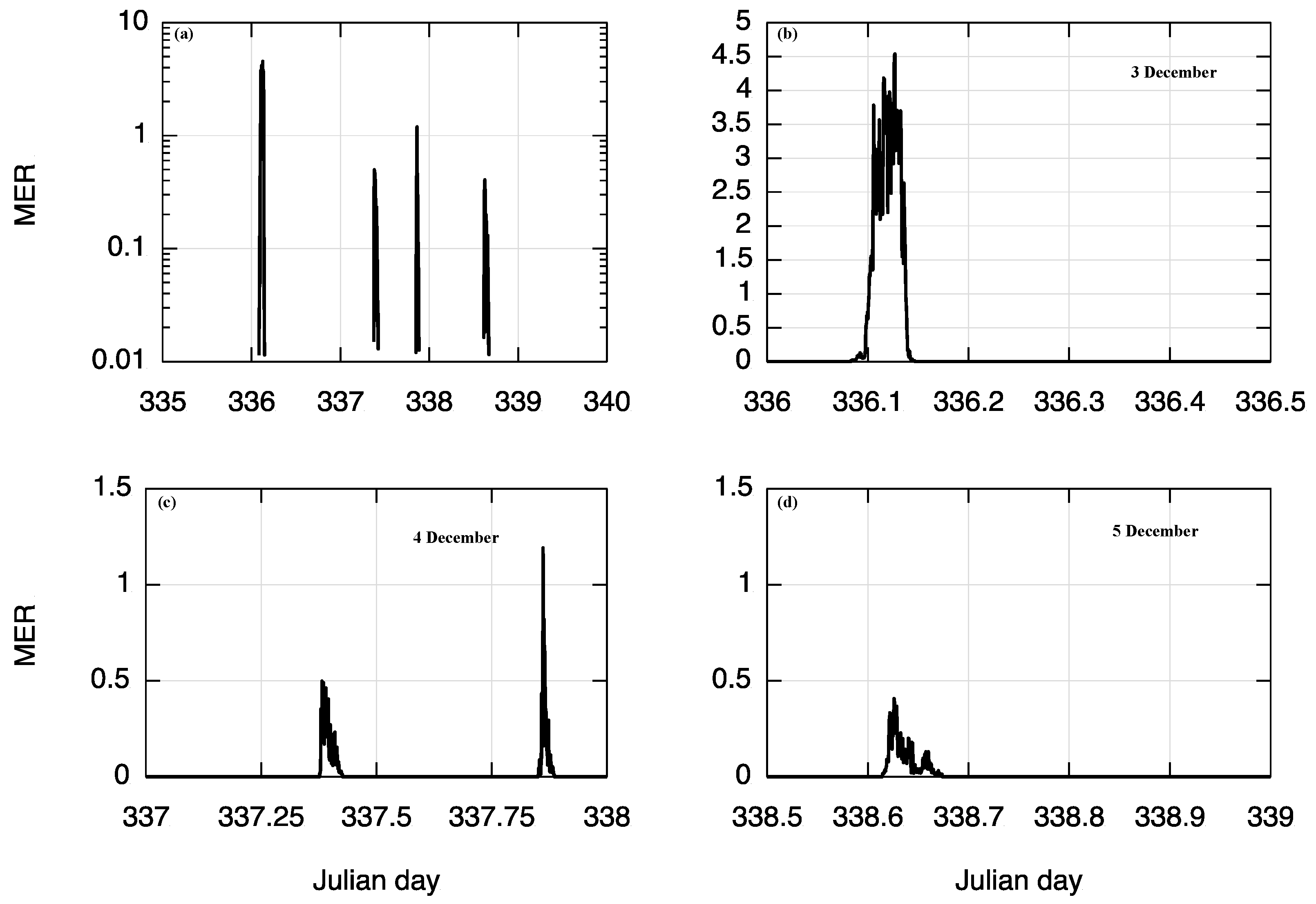
2.3. Determination of the Eruption Height
2.4. Model Description and Setup
3. Results and Discussion: Hazard Maps
3.1. Atmospheric Circulation during the Events: Main Mid-Tropospheric Flows
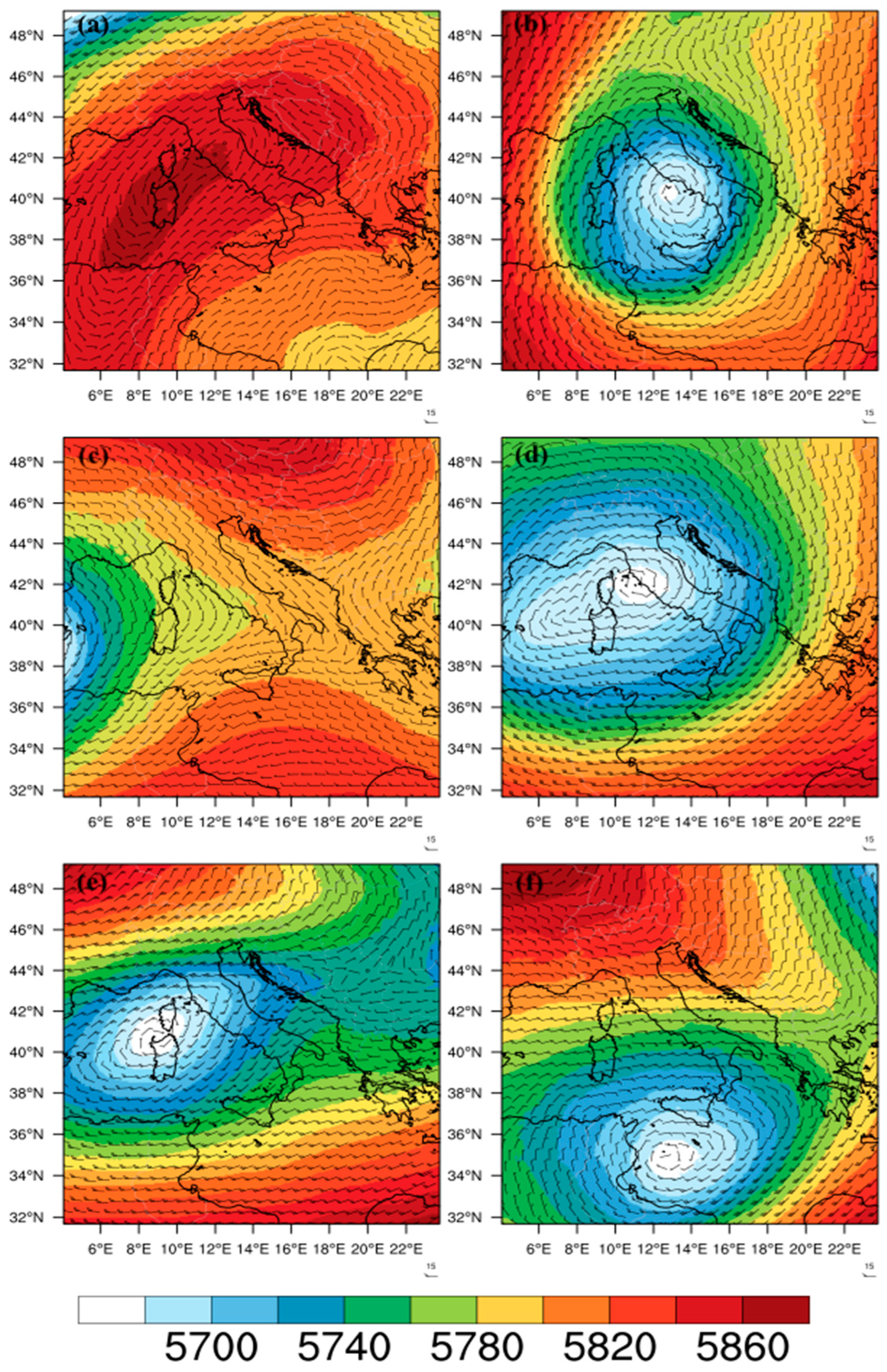
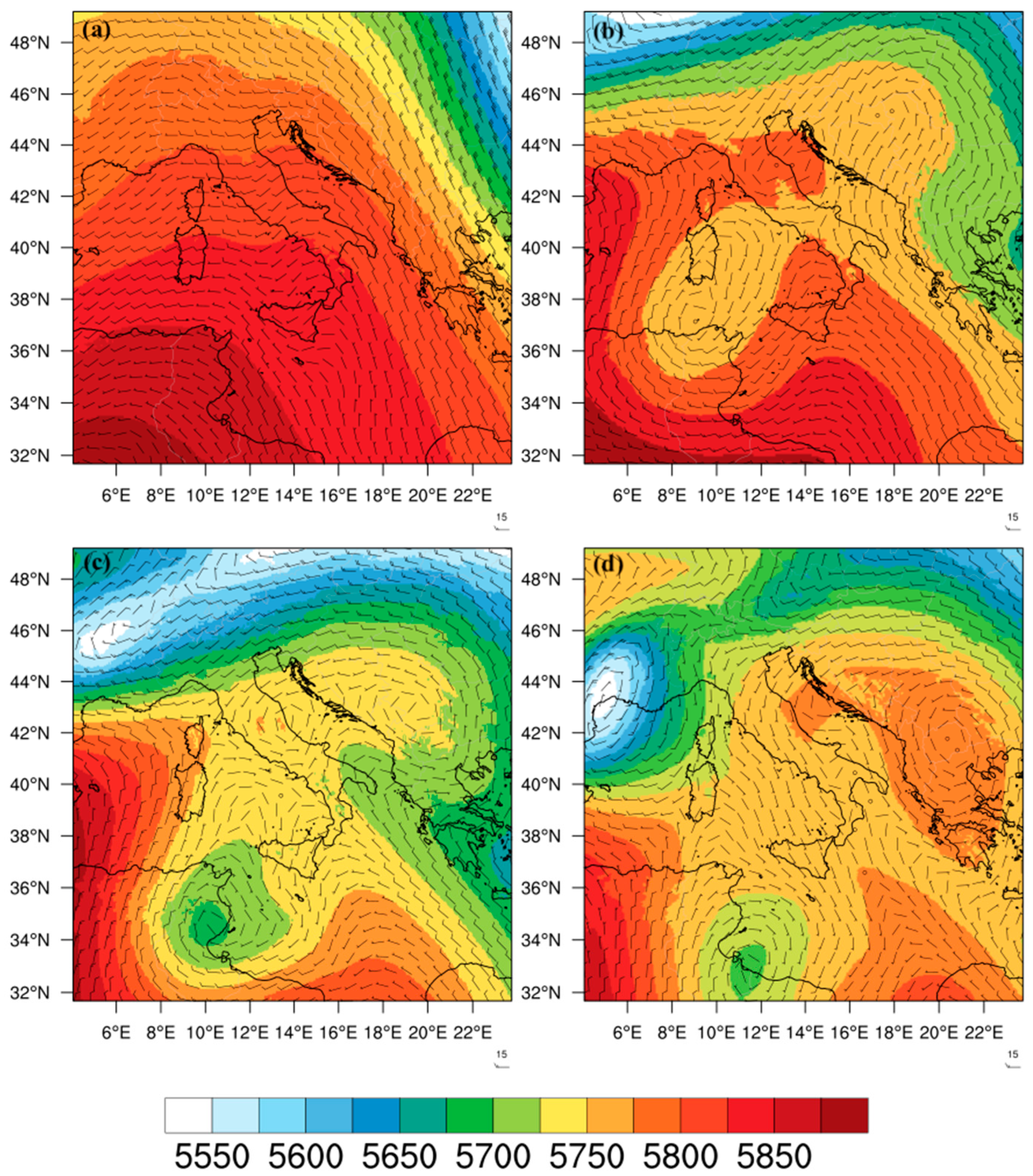
3.2. Analysis of the Volcanic Ash Dispersion Patterns
3.2.1. Time-Averaged Columnar Ash Concentration Maps
3.2.2. Time-Averaged Ash Concentration Maps at Specified Flight Levels
3.2.3. Daily Average Ash Concentration Maps for Selected Paroxysms
3.2.4. Vertical Distribution of Very Fine Ash
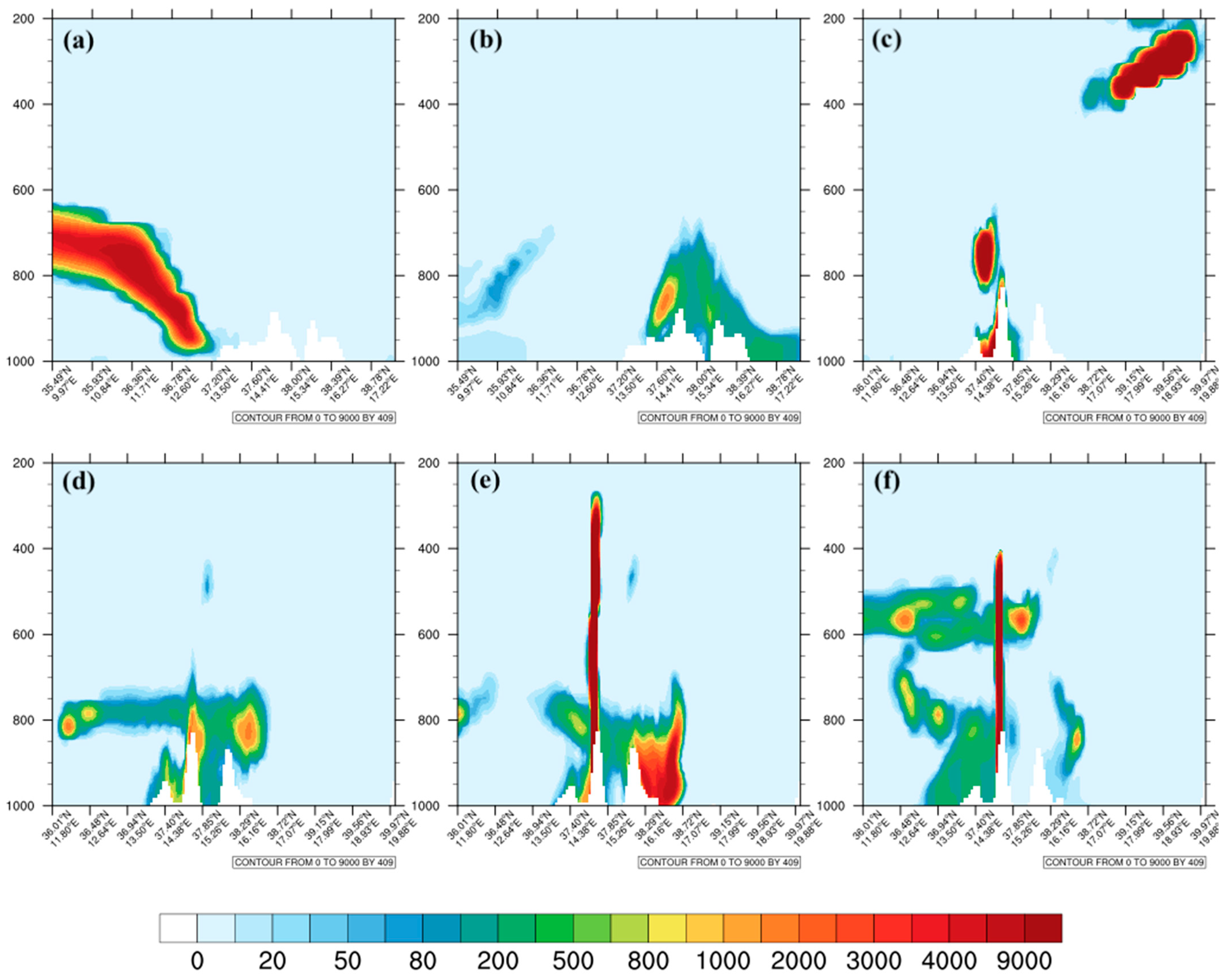
4. Conclusions
- The very fine ash from sequences of Mount Etna paroxysms is shown to easily contaminate the airspace around the volcano within a radius of about 1000 km in a matter of days. The airspace in many countries around the Mediterranean basin is impacted, including most of southern Europe from the Balearic Islands westward, the south of France, the whole of Italy, Greece, and the western coast of Turkey and the Balkans eastward, to beyond the Alps northward, and to Malta and the African northern coast (from Algeria to Libya) southward.
- Low-pressure weather systems favor the trapping and circulation of very fine ash in the whole troposphere within this area, yet at a low concentration, generally below 1 μg m−3. In this meteorological context, high winds tend to stretch ash clouds into ~100 km wide clouds forming large-scale vortices of 800–1600 km in diameter, where PM10 ash concentrations can still exceed the aviation hazard threshold up to 1000 km downwind from the volcano, a distance reached in about 10 h (e.g., NSE5).
- High-pressure, low-wind conditions tend to favor the accumulation of PM10 ash in a wide atmospheric region surrounding Etna. In this context, closely interspersed paroxysms tend to accumulate very fine ash, more diffusively in the lower troposphere and in stretched ash clouds higher up in the troposphere.
- In all the volcanological and meteorological configurations simulated, the lower troposphere appears particularly prone to the accumulation of diffuse PM10 ash during sequences of eruption; this is likely to affect the take-off and landing of aircraft in regional airports in particular.
- High MER paroxysms propel ash up into the upper troposphere, where most of the air traffic occurs, and sometimes also into the lower stratosphere, according to the weather conditions. High-troposphere ash clouds from Etna appear as a pulsed feature resulting mostly from the short-lived climax phase.
- Daily average PM10 tropospheric ash concentrations commonly exceed the aviation hazard threshold, up to 1000 km downwind from the volcano and up to the upper troposphere for intense paroxysms.
- The thickness of the modelled PM10 ash clouds generated from different parts of the eruptive columns ranged from 0.7 to 3 km.
- Potential health hazards may stem from the stagnation of PM10 ash at ground level for several days, commonly above 500 μg m−3, and sometimes punctually exceeding the aviation threshold. Our methodology has the potential to issue timely alerts in an operational setup, including at Catania airport.
Supplementary Materials
Author Contributions
Funding
Data Availability Statement
Acknowledgments
Conflicts of Interest
Appendix A
| N | VA Advisory (UTC) | Aviation Color Code | Eruption Details |
|---|---|---|---|
| 1 | ETNA—2013-10-26 06:00 | NIL | STARTED AT 0200Z |
| 2 | ETNA—2013-10-26 06:00 | NIL | STARTED AT 0200Z |
| 3 | ETNA—2013-10-26 11:30 | NIL | STOPPED AROUND 1100Z |
| 4 | ETNA—2013-10-26 17:30 | NIL | STOPPED AROUND 1100Z |
| 5 | ETNA—2013-10-27 08:13 | NIL | CLOUD SEEMS TO BE COMPOSED OF WATER VAPOUR, NO SIGNAL OF ASH NEITHER VOLCANIC GAS ON SAT IMAGERY |
| 6 | ETNA—2013-10-28 16:00 | NIL | VA NOT IDENTIFIABLE |
| 7 | ETNA—2013-10-29 10:50 | NIL | UNKNOWN |
| 8 | ETNA—2013-11-11 03:43 | NIL | UNKNOWN |
| 9 | ETNA—2013-11-11 10:11 | NIL | CLOUD IDENTIFIABLE ON WEBCAM MAY CONTAIN VA |
| 10 | ETNA—2013-11-16 23:03 | NIL | IN PROGRESS LOW INTENSITY |
| 11 | ETNA—2013-11-17 02:17 | NIL | GOING ON |
| 12 | ETNA—2013-11-17 05:09 | NIL | ERUPTION STOPPED ABOUT 0500Z |
| 13 | ETNA—2013-11-17 11:29 | NIL | ERUPTION ENDED |
| 14 | ETNA—2013-11-23 10:07 | NIL | ASH CLOUD OF SEVERE INTENSITY STARTS AT 0930Z |
| 15 | ETNA—2013-11-23 11:17 | NIL | ERUPTION ENDED AT 1030Z |
| 16 | ETNA—2013-11-23 14:26 | NIL | ERUPTION ENDED AT 1030Z |
| 17 | ETNA—2013-11-23 20:19 | NIL | ERUPTION ENDED |
| 18 | ETNA—2013-11-28 17:37 | NIL | ERUPTION HAS STARTED AT 1730Z, GOING ON |
| 19 | ETNA—2013-11-28 19:50 | NIL | ERUPTION HAS RESTARTED AT 1930Z, GOING ON |
| 20 | ETNA—2013-11-28 23:45 | NIL | ERUPTION HAS STOPPED AT 2330Z |
| 21 | ETNA—2013-12-02 19:00 | NIL | ERUPTION HAS STARTED AT 1820Z, GOING ON |
| 22 | ETNA—2013-12-02 23:40 | NIL | ERUPTION ENDED AT 2300Z |
| 1 | ETNA—2015-12-02 23:00 | ORANGE | STROMBOLIAN ACTIVITY |
| 2 | ETNA—2015-12-03 02:41 | RED | EXPLOSIVE ERUPTION OCCURRED AT 02000Z |
| 3 | ETNA—2015-12-03 04:00 | ORANGE | ERUPTION AND ASH EMISSION DECREASING. VA IDENTIFIABLE FM SATELLITE IMAGERY |
| 4 | ETNA—2015-12-03 10:00 | ORANGE | SMALL ACTIVITY IN VICINITY OF VOLCANO |
| 5 | ETNA—2015-12-03 14:00 | YELLOW | NO SIGNIFICANT ASH EMISSION |
| 6 | ETNA—2015-12-04 09:40 | RED | ASH EMISSION VISIBLE ON WEBCAM |
| 7 | ETNA—2015-12-04 10:45 | RED | ERUPTION ONGOING |
| 8 | ETNA—2015-12-04 15:45 | RED | ASH PLUME NEAR SUMMIT VOLCANO |
| 9 | ETNA—2015-12-04 21:00 | RED | ERUPTION STARTED AT 2045Z |
| 10 | ETNA—2015-12-05 03:00 | RED | STROMBOLIAN EXPLOSIONS |
| 11 | ETNA—2015-12-05 08:45 | RED | STROMBOLIAN EXPLOSIONS |
| 12 | ETNA—2015-12-05 15:00 | ORANGE | SOME VOLCANIC ASH NEAR THE SUMMIT |
| 13 | ETNA—2015-12-05 15:05 | RED | SIGNIFICANT EMISSION OF ASH OVER THE VOLCANO |
| 14 | ETNA—2015-12-05 20:31 | ORANGE | EXPLOSIVE ACTIVITY AND SIGNIFICANT ASH EMISSION STOPPED |
| 15 | ETNA—2015-12-06 11:45 | ORANGE | VOLCANIC ASH NEAR THE SUMMIT |
| 16 | ETNA—2015-12-06 12:00 | ORANGE | VOLCANIC ASH NEAR THE SUMMIT |
| 17 | ETNA—2015-12-06 13:00 | RED | INCREASING ACTIVITY |
| 18 | ETNA—2015-12-06 17:55 | RED | ONGOING MODERATE INTENSITY |
| 19 | ETNA—2015-12-06 23:00 | RED | EXPLOSIVE ACTIVITY |
| 20 | ETNA—2015-12-07 03:00 | RED | ACTIVITY STILL ONGOING |
| 21 | ETNA—2015-12-07 09:00 | ORANGE | ACTIVITY STILL ONGOING |
| 22 | ETNA—2015-12-07 15:00 | RED | VA NOT IDENTIFIABLE FM SAT DATA, WINDS FL100 280/10KT FL300 290/15KT |
| 23 | ETNA—2015-12-07 20:50 | RED | SPORADIC ERUPTIONS STILL GOING ON |
| 24 | ETNA—2015-12-08 03:00 | RED | SPORADIC ERUPTIONS STILL GOING ON |
| 25 | ETNA—2015-12-08 09:00 | ORANGE | STROMBOLIAN ACTIVITY HAS DECREASED |
| 26 | ETNA—2015-12-09 04:00 | ORANGE | ERUPTION STILL GOING ON |
| 27 | ETNA—2015-12-09 09:17 | RED | ERUPTION STILL GOING ON |
| 28 | ETNA—2015-12-09 14:50 | RED | SEEMS TO BE DECREASING |
| 29 | ETNA—2015-12-09 20:45 | ORANGE | WEAK ERUPTIVE ACTIVITY IS ONGOING |
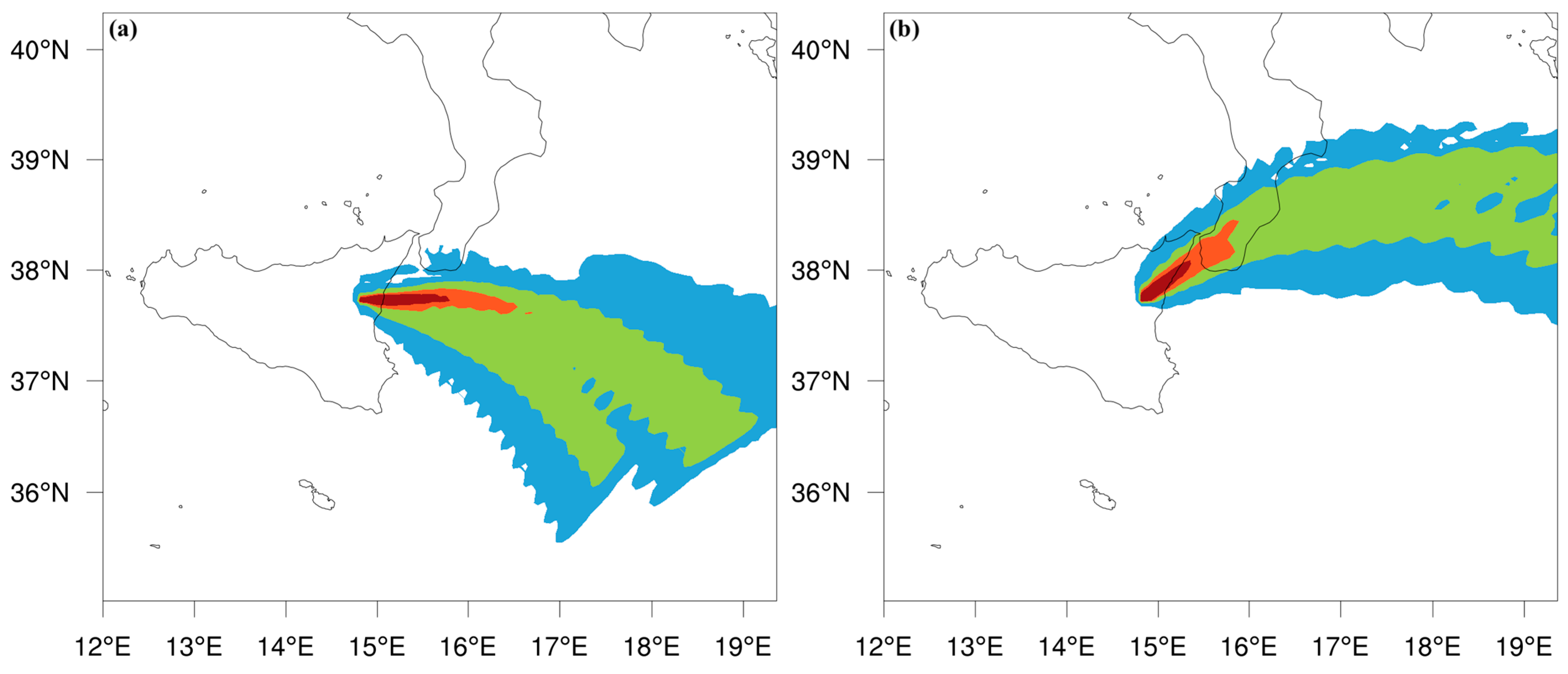
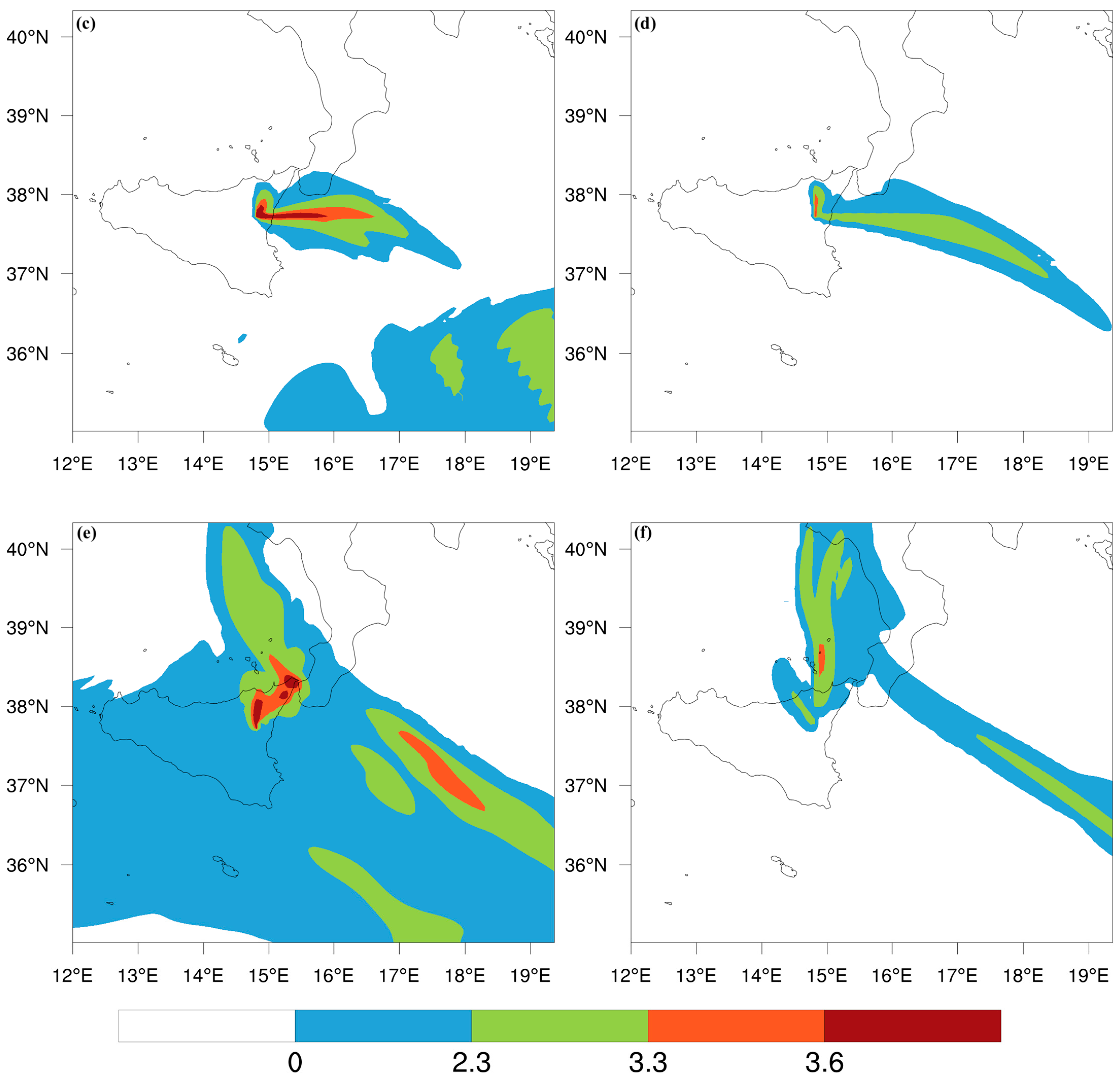
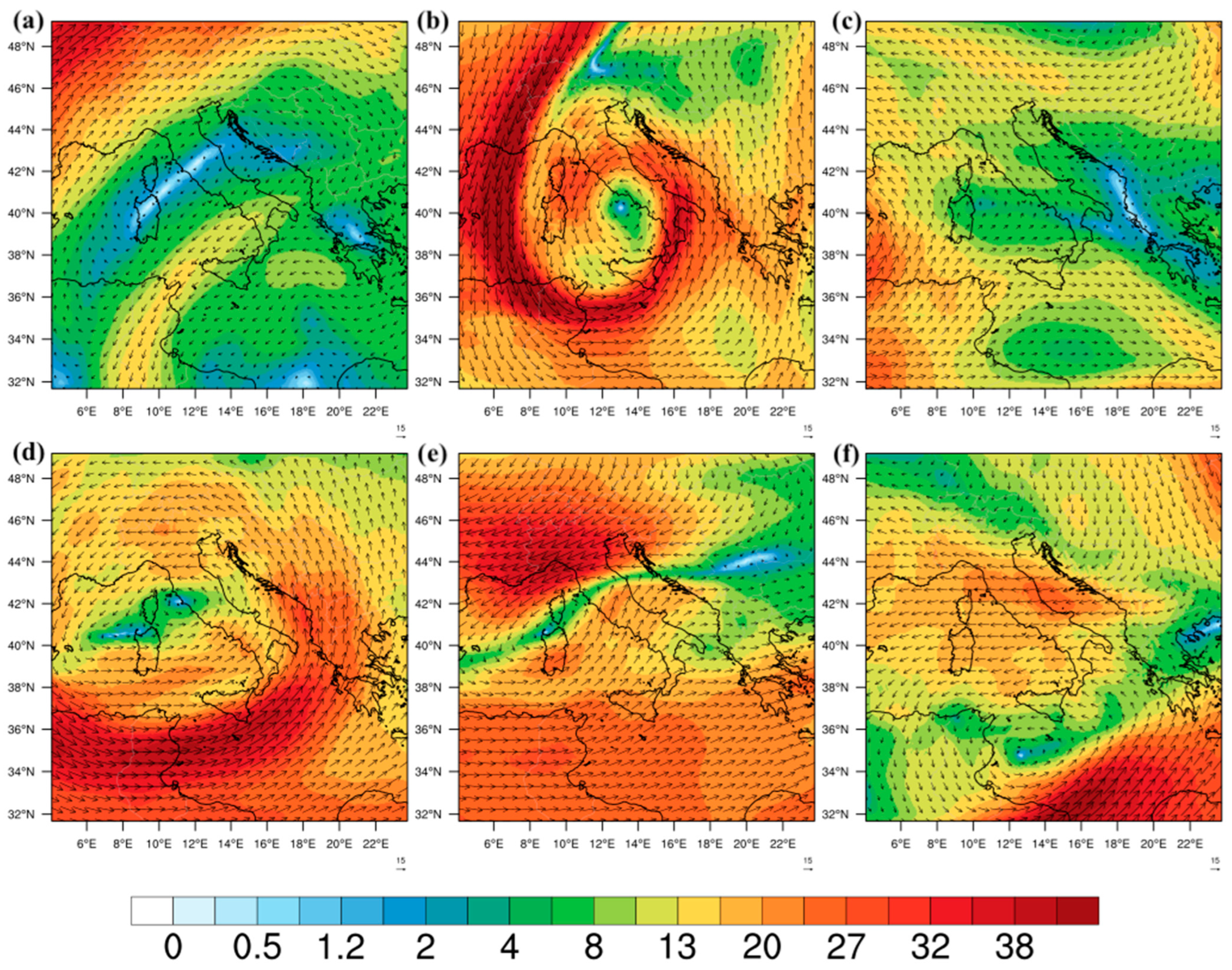
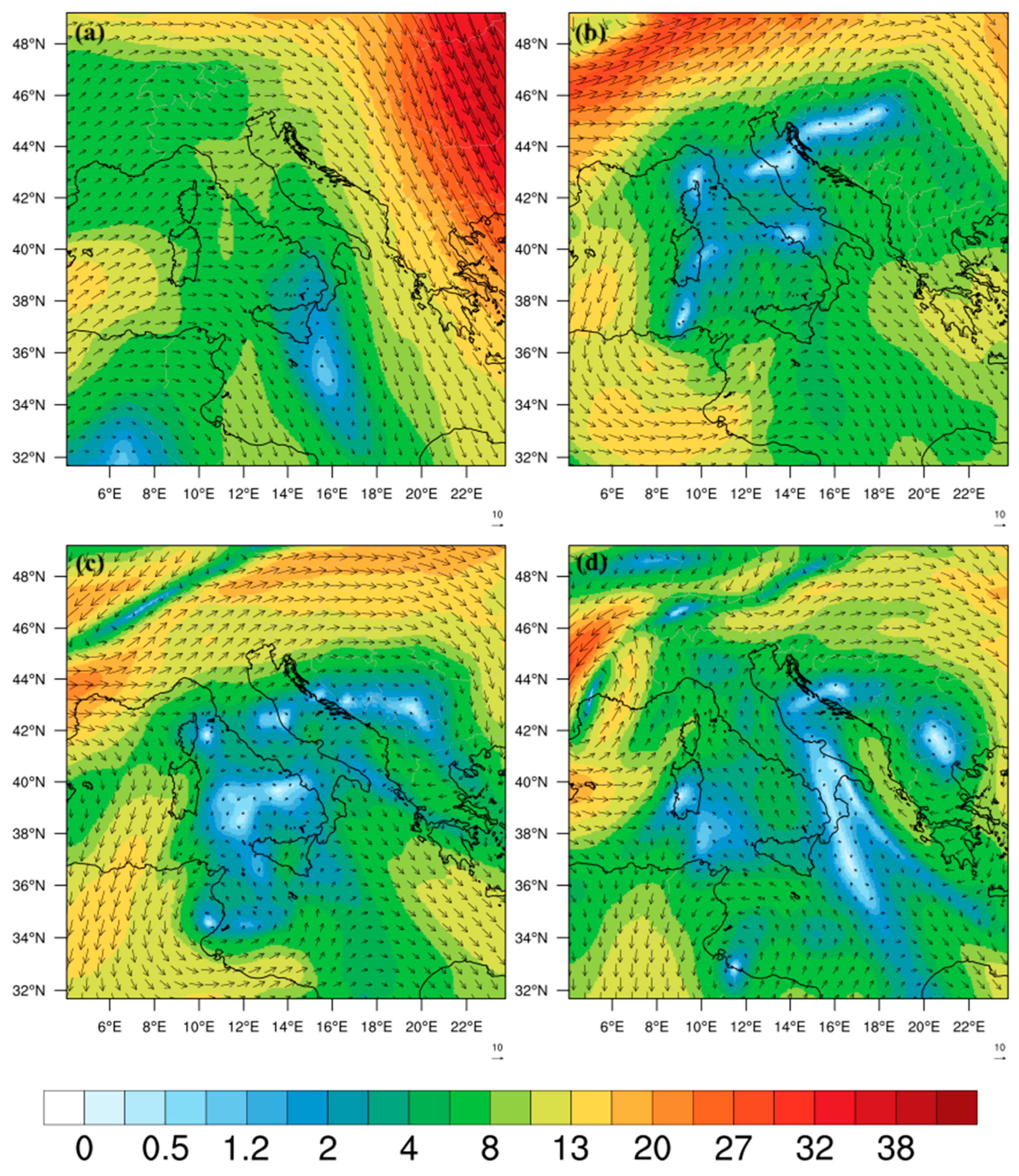
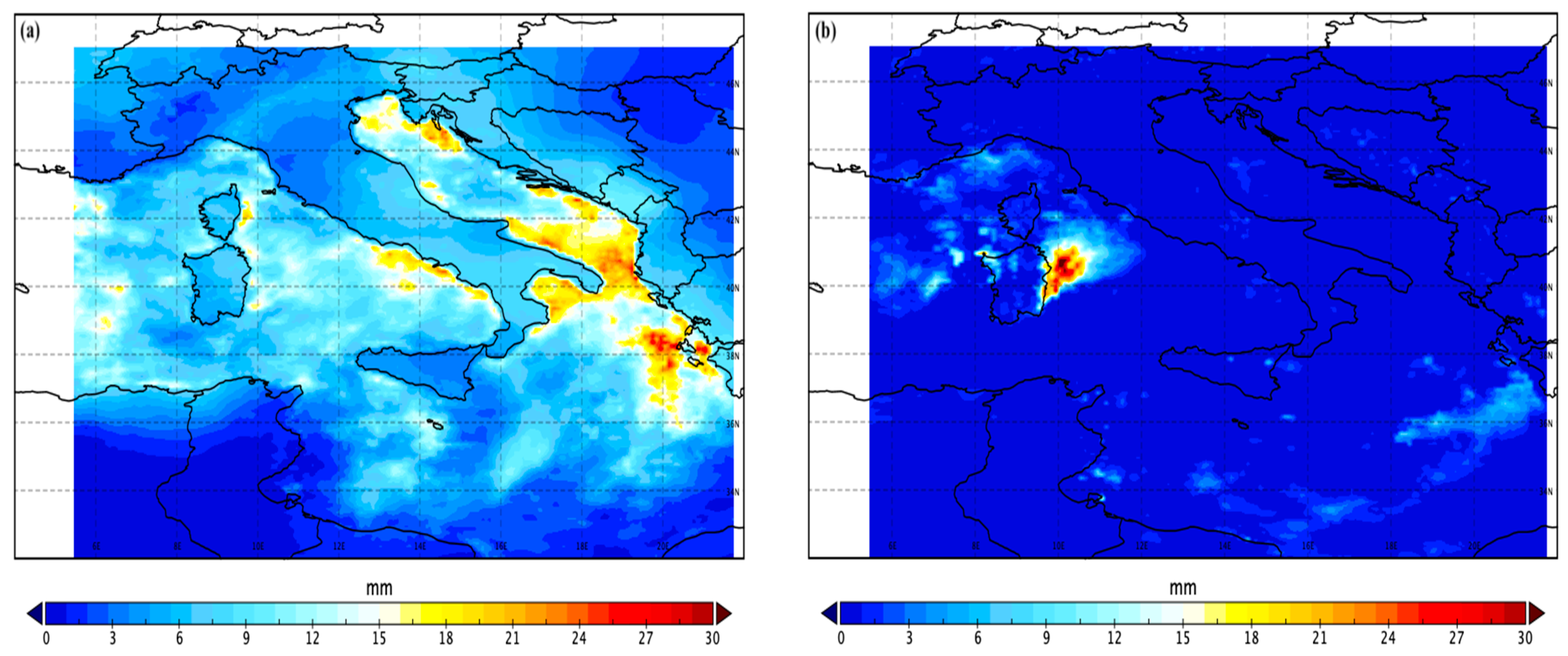
References
- Prata, F.; Rose, B. Volcanic ash hazards to aviation. In The Encyclopedia of Volcanoes, 2nd ed.; Sigurdsson, H., Ed.; Academic Press: Cambridge, MA, USA; Elsevier: Amsterdam, The Netherlands, 2015; pp. 911–934. [Google Scholar] [CrossRef]
- International Civil Aviation Organization (ICAO). Flight Safety and Volcanic Ash, 2012. Doc 9974, ANB/487. Available online: https://www.icao.int/publications/Documents/9974_en.pdf (accessed on 10 February 2023).
- Jiménez-Escalona, J.C.; Poom-Medina, J.L.; Roberge, J.; Aparicio-García, R.S.; Avila-Razo, J.E.; Huerta-Chavez, O.M.; Da Silva, R.F. Recognition of the Airspace Affected by the Presence of Volcanic Ash from Popocatepetl Volcano Using Historical Satellite Images. Aerospace 2022, 9, 308. [Google Scholar] [CrossRef]
- Marchese, F.; Falconieri, A.; Filizzola, C.; Pergola, N.; Tramutoli, V. Investigating Volcanic Plumes from Mt. Etna Eruptions of December 2015 by Means of AVHRR and SEVIRI Data. Sensors 2019, 19, 1174. [Google Scholar] [CrossRef] [PubMed]
- Eychenne, J.; Gurioli, L.; Damby, D.; Belville, C.; Schiavi, F.; Marceau, G.; Szczepaniaks, C.; Blavignacs, C.; Laumonier, M.; Gardes, E.; et al. Spatial distribution and physicochemical properties of respirable volcanic ash from the 16-17 August 2006 Tungurahua eruption (Ecuador), and alveolar epithelium response in-vitro. GeoHealth 2022, 6, e2022GH000680. [Google Scholar] [CrossRef]
- Sellitto, P.; Salerno, G.; Corradini, S.; Xueref-Remy, I.; Riandet, A.; Bellon, C.; Khaykin, S.; Ancellet, G.; Lolli, S.; Welton, E.J.; et al. Volcanic emissions, plume dispersion, and downwind radiative impacts following Mount Etna series of eruptions of February 21–26, 2021. J. Geophys. Res. Atmos. 2023, 128, e2021JD035974. [Google Scholar] [CrossRef]
- EUROCONTROL. 11 Years after the Eruption of Icelandic Volcano Eyjafjallajökull. Available online: https://www.eurocontrol.int/news/11-years-after-eruption-icelandic-volcano-eyjafjallajokull (accessed on 23 June 2023).
- Hirtl, M.; Arnold, D.; Baro, R.; Brenot, H.; Coltelli, M.; Eschbacher, K.; Hard-Stremayer, H.; Lipok, F.; Maurer, C.; Meinhard, D.; et al. A volcanic-hazard demonstration exercise to assess and mitigate the impacts of volcanic ash clouds on civil and military aviation. Nat. Hazards Earth Syst. Sci. 2020, 20, 1719–1739. [Google Scholar] [CrossRef]
- Guffanti, M.; Casadevall, T.J.; Budding, K. Encounters of Aircraft with Volcanic Ash Clouds: A Compilation of Known Incidents, 1953–2009: U.S. Geological Survey Data Series, 2010, 545, Ver. 1.0, 12 p., Plus 4 Appendixes Including the Compilation Database. Available online: https://pubs.usgs.gov/ds/545/ (accessed on 14 February 2023).
- Christmann, C.; Nunes, R.R.; Schmitt, A.R. Recent Encounters of Aircraft with Volcanic Ash Clouds. Deutscher Luft-und Raumfahrtkongress (DLR), 2015, DocumentID: 370124. Available online: https://www.dglr.de/publikationen/2015/370124.pdf (accessed on 14 February 2023).
- Thouret, J.-C.; Charbonnier, S. Assessment, Delineation of Hazard Zones and Modeling of Volcanic Hazards. In Hazards and Monitoring of Volcanic Activity 1; Lénat, J.-F., Ed.; ISTE-Géosciences: Lausanne, Switzerland, 2022; pp. 151–184. ISBN 978-1-78945-043-9. [Google Scholar] [CrossRef]
- Folch, A. A review of tephra transport and dispersal models: Evolution, current status, and future perspectives. J. Volcanol. Geotherm. Res. 2012, 235–236, 96–115. [Google Scholar] [CrossRef]
- Harvey, N.J.; Huntley, N.; Dacre, H.F.; Goldstein, M.; Thomson, D.; Webster, H. Multi-level emulation of a volcanic ash transport and dispersion model to quantify sensitivity to uncertain parameters. Nat. Hazards Earth Syst. Sci. 2018, 18, 41–63. [Google Scholar] [CrossRef]
- Aubry, T.J.; Engwell, S.; Bonadonna, C.; Carazzo, G.; Scollo, S.; Van Eaton, A.R.; Taylor, I.A.; Jessop, D.; Eychenne, J.; Gouhier, M.; et al. The Independent Volcanic, Eruption Source Parameter Archive (IVESPA, versio 1.0): A new observational database to support explosive eruptive column model validation and development. J. Volcanol. Geotherm. Res. 2021, 417, 107295. [Google Scholar] [CrossRef]
- Egan, S.D.; Stuefer, M.; Webley, P.W.; Lopez, T.; Cahill, C.F.; Hirtl, M. Modeling volcanic ash aggregation processes and related impacts on the April–May 2010 eruptions of Eyjafjallajökull volcano with WRF-Chem. Nat. Hazards Earth Syst. Sci. 2020, 20, 2721–2737. [Google Scholar] [CrossRef]
- Grell, G.A.; Peckham, S.E.; Schmitz, R.; McKeen, S.A.; Frost, G.; Skamarock, W.C.; Eder, B. Fully coupled “online” chemistry within the WRF model. Atmos. Environ. 2005, 39, 6957–6976. [Google Scholar] [CrossRef]
- Rizza, U.; Brega, E.; Caccamo, M.T.; Castorina, G.; Morichetti, M.; Munaò, G.; Passerini, G.; Magazù, S. Analysis of the ETNA 2015 Eruption Using WRF–Chem Model and Satellite Observations. Atmosphere 2020, 11, 1168. [Google Scholar] [CrossRef]
- Rizza, U.; Donnadieu, F.; Magazu, S.; Passerini, G.; Castorina, G.; Semprebello, A.; Morichetti, M.; Virgili, S.; Mancinelli, E. Effects of Variable Eruption Source Parameters on Volcanic Plume Transport: Example of the 23 November 2013 Paroxysm of Etna. Remote Sens. 2021, 13, 4037. [Google Scholar] [CrossRef]
- Donnadieu, F.; Freville, P.; Hervier, C.; Coltelli, M.; Scollo, S.; Prestifilippo, M.; Valade, S.; Rivet, S.; Cacault, P. Near-source Doppler radar monitoring of tephra plumes at Etna. J. Volcanol. Geotherm. Res. 2016, 312, 26–39. [Google Scholar] [CrossRef]
- Freret-Lorgeril, V.; Donnadieu, F.; Scollo, S.; Provost, A.; Fréville, P.; Guéhenneux, Y.; Hervier, C.; Prestifilippo, M.; Coltelli, M. Mass Eruption Rates of Tephra Plumes during the 2011–2015 Lava Fountain Paroxysms at Mt. Etna From Doppler Radar Retrievals. Front. Earth Sci. 2018, 6, 73. [Google Scholar] [CrossRef]
- Bonaccorso, A.; Calvari, S.; Linde, A.; Sacks, S. Eruptive processes leading to the most explosive lava fountain at Etna volcano: The 23 November 2013 episode. Geophys. Res. Lett. 2014, 41, 4912–4919. [Google Scholar] [CrossRef]
- Poret, M.; Corradini, S.; Merucci, L.; Costa, A.; Andronico, D.; Montopoli, M.; Vulpiani, G.; Freret-Lorgeril, V. Reconstructing volcanic plume evolution integrating satellite and ground-based data: Application to the 23 November 2013 Etna eruption. Atmos. Chem. Phys. Discuss. 2018, 18, 4695–4714. [Google Scholar] [CrossRef]
- Corradini, S.; Guerrieri, L.; Lombardo, V.; Merucci, L.; Musacchio, M.; Prestifilippo, M.; Scollo, S.; Silvestri, M.; Spata, G.; Stelitano, D. Proximal Monitoring of the 2011–2015 Etna Lava Fountains Using MSG-SEVIRI Data. Geosciences 2018, 8, 140. [Google Scholar] [CrossRef]
- Corsaro, R.A.; Andronico, D.; Behncke, B.; Branca, S.; Caltabiano, T.; Ciancitto, F.; Cristaldi, A.; De Beni, E.; La Spina, A.; Lodato, L.; et al. Monitoring the December 2015 summit eruptions of Mt. Etna (Italy): Implications on eruptive dynamics. J. Volcanol. Geotherm. Res. 2017, 341, 53–69. [Google Scholar] [CrossRef]
- Crafford, A.E.; Venzke, E. (Eds.) Global Volcanism Program. Report on Etna (Italy). In Bulletin of the Global Volcanism Network; Smithsonian Institution: Washington, DC, USA, 2017; Volume 42, p. 5. [Google Scholar] [CrossRef]
- Bonaccorso, A.; Calvari, S. A new approach to investigate an eruptive paroxysmal sequence using camera and strainmeter networks: Lessons from the 3–5 December 2015 activity at Etna volcano. Earth Planet. Sci. Lett. 2017, 475, 231–241. [Google Scholar] [CrossRef]
- Bonforte, A.; Cannavo, F.; Gambino, S.; Guglielmo, F. Combining High- and Low-Rate Geodetic Data Analysis for Unveiling Rapid Magma Transfer Feeding a Sequence of Violent Summit Paroxysms at Etna in Late 2015. Appl. Sci. 2021, 11, 4630. [Google Scholar] [CrossRef]
- Donnadieu, F.; Freret-Lorgeril, V.; Gouhier, M.; Coltelli, M.; Scollo, S.; Fréville, P.; Hervier, C.; Prestifilippo, M. The 3 December 2015 paroxysm of Voragine crater at Etna: Insights from Doppler radar measurements. Geophys. Res. Abstr. 2016, 18, EGU2016-17201-1. [Google Scholar]
- Dubosclard, G.; Donnadieu, F.; Allard, P.; Cordesses, R.; Hervier, C.; Coletllie, M.; Privitera, E.; Kornprobst, J. Doppler radar sounding of volcanic eruption dynamics at Mount Etna. Bull. Volcanol. 2004, 66, 443–456. [Google Scholar] [CrossRef]
- Marzano, F.S.; Mereu, L.; Scollo, S.; Donnadieu, F.; Bonadonna, C. Tephra Mass Eruption Rate from X-Band and L-Band Microwave Radars during the 2013 Etna Explosive Lava Fountain. IEEE Trans. Geosci. Remote Sens. 2020, 58, 3314–3327. [Google Scholar] [CrossRef]
- Freret-Lorgeril, V.; Bonadonna, C.; Corradini, S.; Donnadieu, F.; Guerrieri, L.; Lacanna, G.; Marzano, F.; Mereu, L.; Merucci, L.; Ripepe, M.; et al. Examples of Multi-Sensor Determination of Eruptive Source Parameters of Explosive Events at Mount Etna. Remote Sens. 2021, 13, 2097. [Google Scholar] [CrossRef]
- Mereu, L.; Scollo, S.; Bonadonna, C.; Donnadieu, F.; Freret-Lorgeril, V.; Marzano, F.S. Ground-Based Remote Sensing and Uncertainty Analysis of the Mass Eruption Rate Associated With the 3–5 December 2015 Paroxysms of Mt. Etna. IEEE J. Sel. Top. Appl. Earth Obs. Remote Sens. 2022, 15, 504–518. [Google Scholar] [CrossRef]
- Donnadieu, F.; Freville, P.; Rivet, S.; Hervier, C.; Cacault, P. The Volcano Doppler Radar Data Base of Etna (VOLDORAD-2B); Université Clermont Auvergne CNRS: Clermont-Ferrand, France, 2015. [Google Scholar] [CrossRef]
- Degruyter, W.; Bonadonna, C. Improving on mass flow rate estimates of volcanic eruptions. Geophys. Res. Lett. 2012, 39, L16308. [Google Scholar] [CrossRef]
- Mastin, L.G.; Guffanti, M.; Servranckx, R.; Webley, P.; Barsotti, S.; Dean, K.; Durant, A.; Ewert, J.W.; Neri, A.; Rose, W.I.; et al. A multidisciplinary effort to assign realistic source parameters to models of volcanic ash-cloud transport and dispersion during eruptions. J. Volcanol. Geotherm. Res. 2009, 186, 10–21. [Google Scholar] [CrossRef]
- Stuefer, M.; Freitas, S.R.; Grell, G.; Webley, P.; Peckham, S.; McKeen, S.A.; Egan, S.D. Inclusion of ash and SO2 emissions from volcanic eruptions in WRF-Chem: Development and some applications. Geosci. Model Dev. 2013, 6, 457–468. [Google Scholar] [CrossRef]
- Shi, J.J.; Matsui, T.; Tao, W.K.; Tan, Q.; Peters-Lidard, C.; Chin, M.; Pickering, K.; Guy, N.; Lang, S.; Kemp, E.M. Implementation of an aerosol–cloud-microphysics–radiation coupling into the NASA unified WRF: Simulation results for the 6–7 August 2006 AMMA special observing period. Q. J. R. Meteorol. Soc. 2014, 140, 2158–2175. [Google Scholar] [CrossRef]
- Rizza, U.; Avolio, E.; Morichetti, M.; Di Liberto, L.; Bellini, A.; Barnaba, F.; Virgili, S.; Passerini, G.; Mancinelli, E. On the Interplay between Desert Dust and Meteorology Based on WRF-Chem Simulations and Remote Sensing Observations in the Mediterranean Basin. Remote Sens. 2023, 15, 435. [Google Scholar] [CrossRef]
- Janjic, Z.I. The Step–Mountain Eta Coordinate Model: Further developments of the convection, viscous sublayer, and turbulence closure schemes. Mon. Weather Rev. 1994, 122, 927–945. [Google Scholar] [CrossRef]
- Janjic, Z.I. The surface layer in the NCEP Eta Model. In Proceedings of the Eleventh Conference on Numerical Weather Prediction, Norfolk, VA, USA, 19–23 August 1996; pp. 354–355. [Google Scholar]
- Niu, G.-Y.; Yang, Z.-L.; Mitchell, K.E.; Chen, F.; Ek, M.B.; Barlage, M.; Kumar, A.; Manning, K.; Niyogi, D.; Rosero, E.; et al. The community Noah land surface model with multiparameterization options (Noah–MP): 1. Model description and evaluation with local–scale measurements. J. Geophys. Res. 2011, 116, D12109. [Google Scholar] [CrossRef]
- Chou, M.D.; Suarez, M.J. A solar radiation parameterization for atmospheric studies. NASA Tech. Memo. 1999, 15, 40. [Google Scholar]
- Lang, S.E.; Tao, W.K.; Chern, J.D.; Wu, D.; Li, X. Benefits of a fourth ice class in the simulated radar reflectivities of convective systems using a bulk microphysics scheme. J. Atmos. Sci. 2014, 71, 3583–3612. [Google Scholar] [CrossRef]
- UK Civil Aviation Authority: CAP1236: Guidance Regarding Flight Operations in the Vicinity of Volcanic Ash, 33 pp. 2017. Available online: https://publicapps.caa.co.uk/docs/33/CAP%201236%20FEB17.pdf (accessed on 21 May 2023).
- Climate Data Store. Available online: https://cds.climate.copernicus.eu/#!/home (accessed on 4 September 2022).
- Aubry, T.J.; Engwell, S.L.; Bonadonna, C.; Mastin, L.G.; Carazzo, G.; Van Eaton, A.R.; Jessop, D.E.; Grainger, R.G.; Scollo, S.; Taylor, I.A.; et al. New insights into the relationship between mass eruption rate and volcanic column height based on the IVESPA data set. Geophys. Res. Lett. 2023, 50, e2022GL102633. [Google Scholar] [CrossRef]
- Plu, M.; Scherllin-Pirscher, B.; Arnold Arias, D.; Baro, R.; Bigeard, G.; Bugliaro, L.; Carvalho, A.; El Amraoui, L.; Eschbacher, K.; Hirtl, M.; et al. An ensemble of state-of-the-art ash dispersion models: Towards probabilistic forecasts to increase the resilience of air traffic against volcanic eruptions. Nat. Hazards Earth Syst. Sci. 2021, 21, 2973–2992. [Google Scholar] [CrossRef]
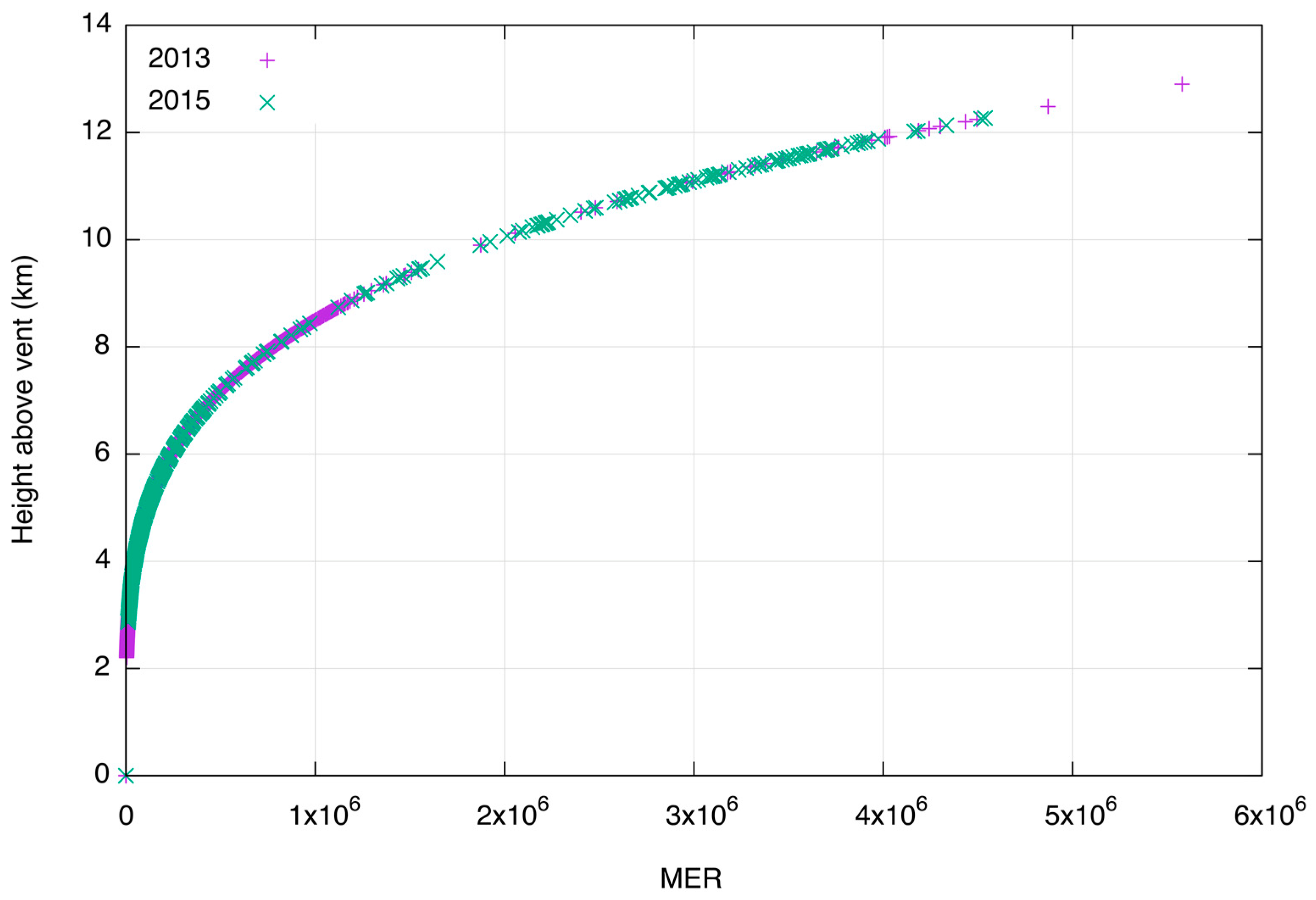
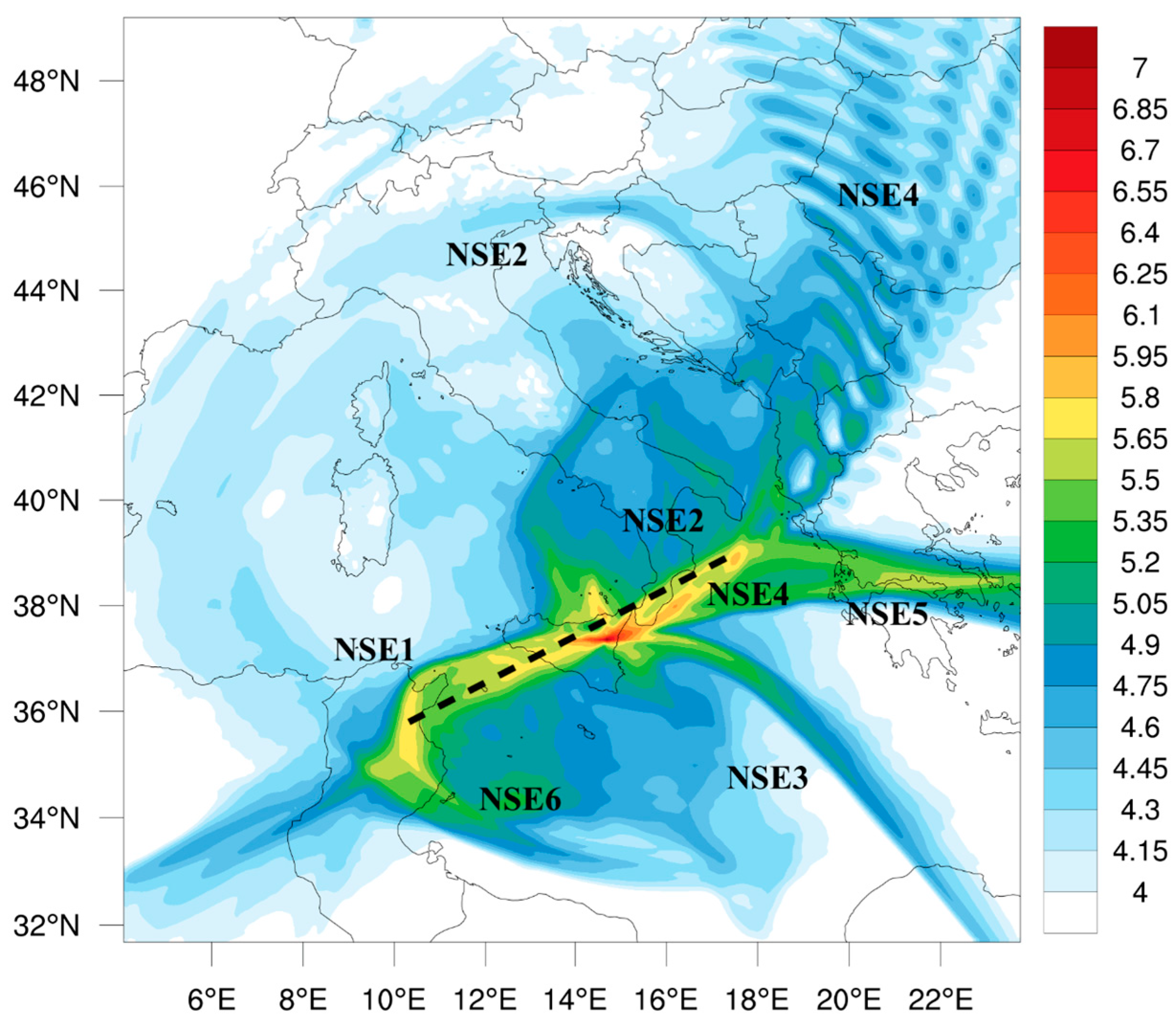
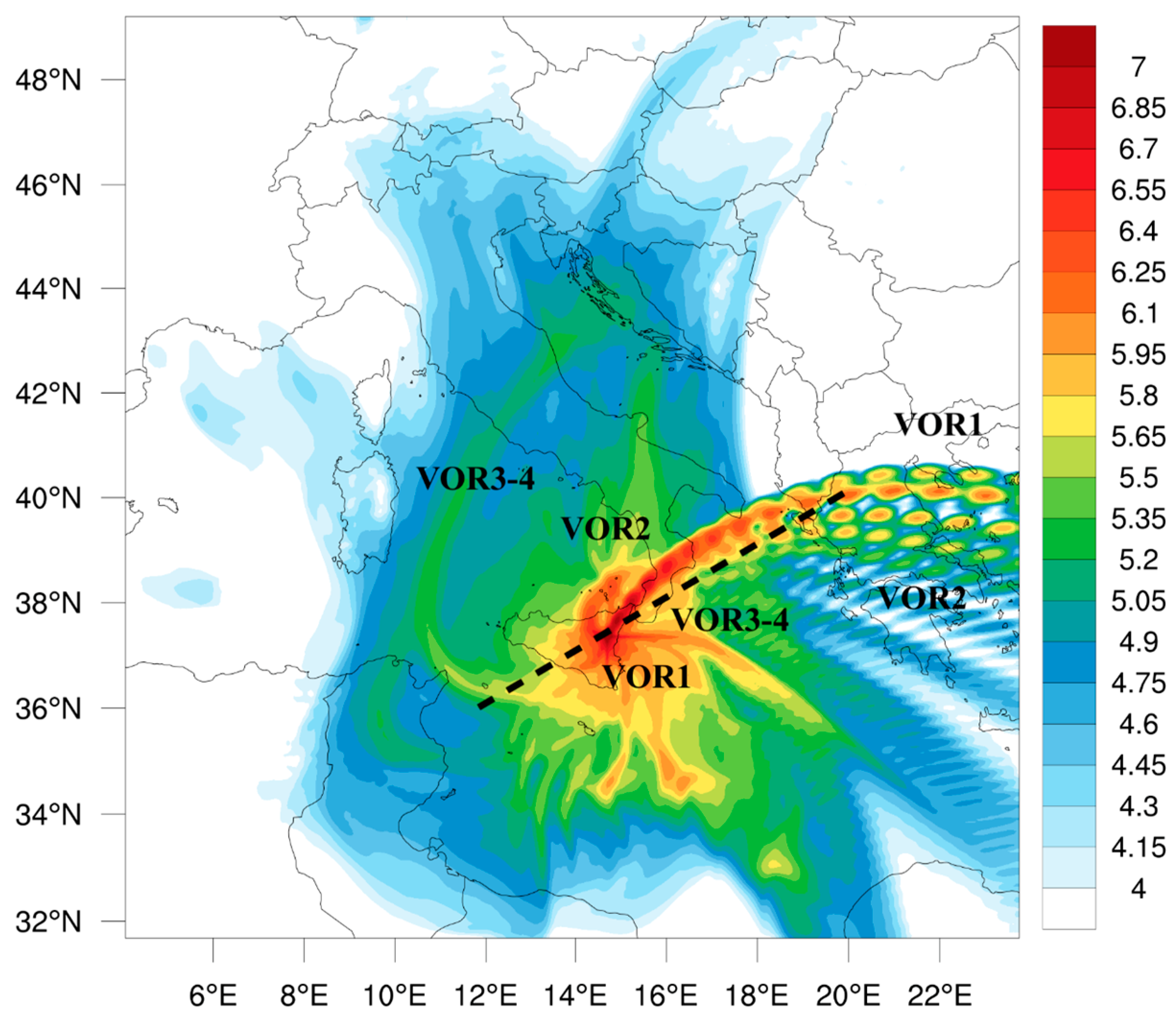
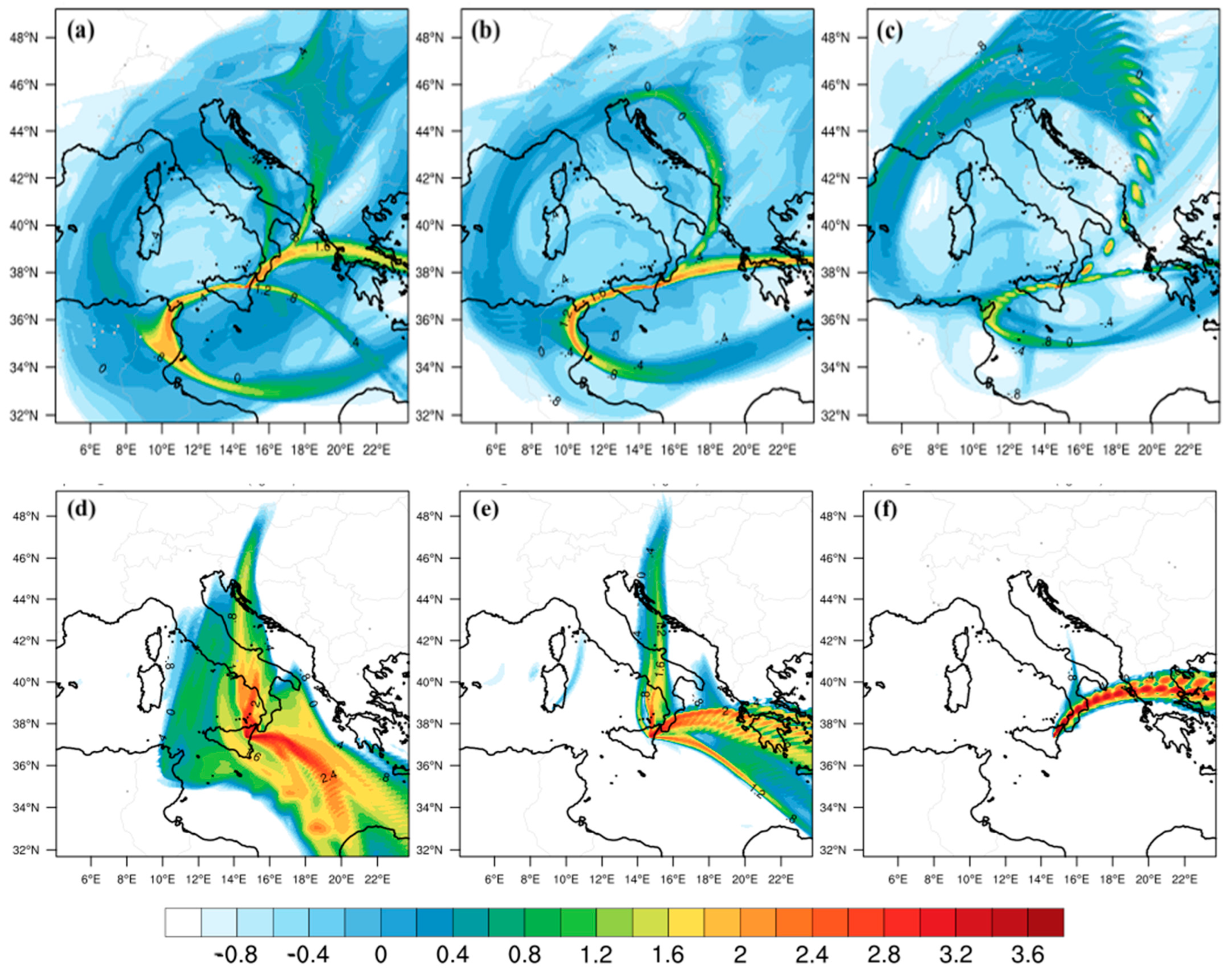
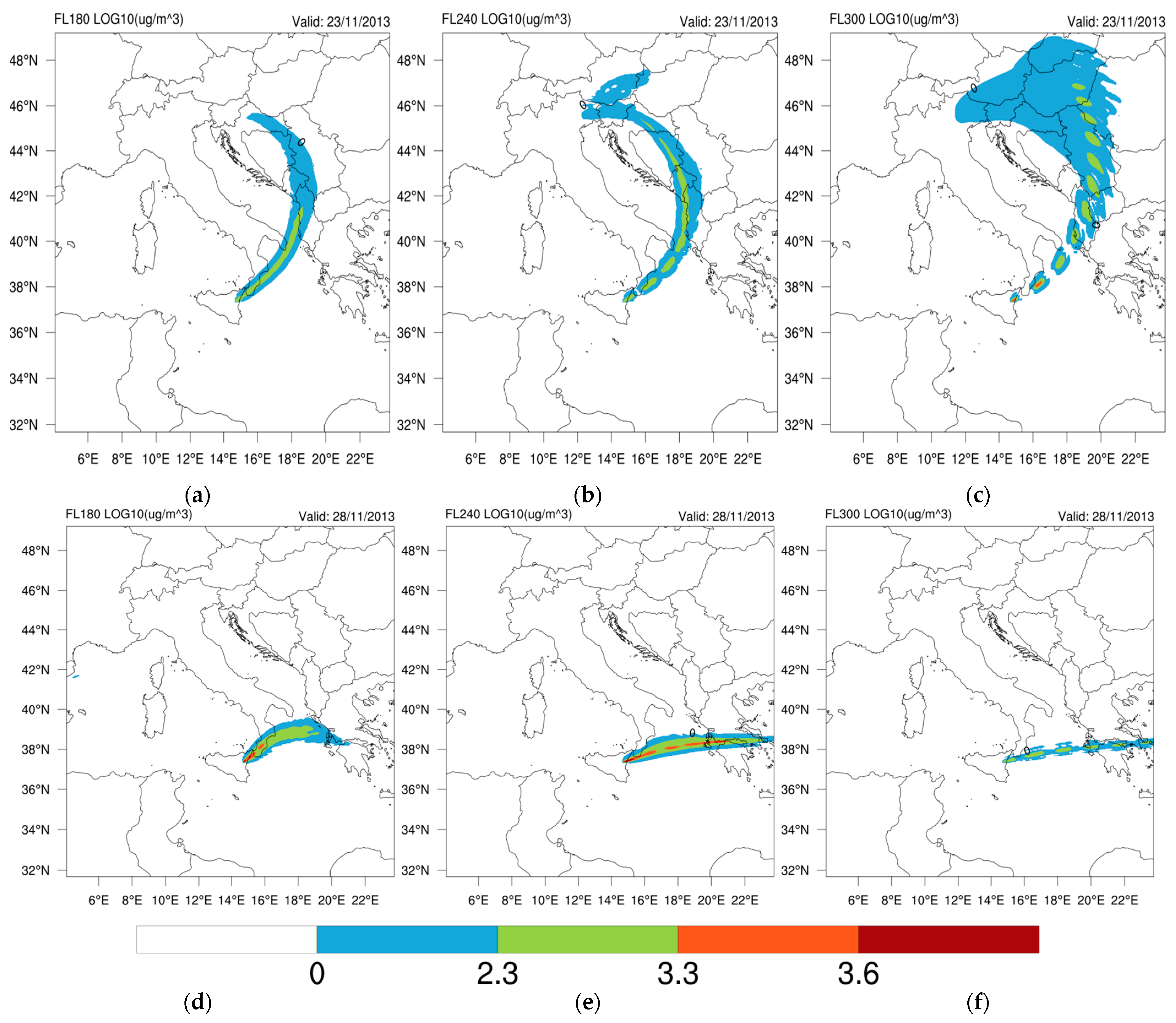
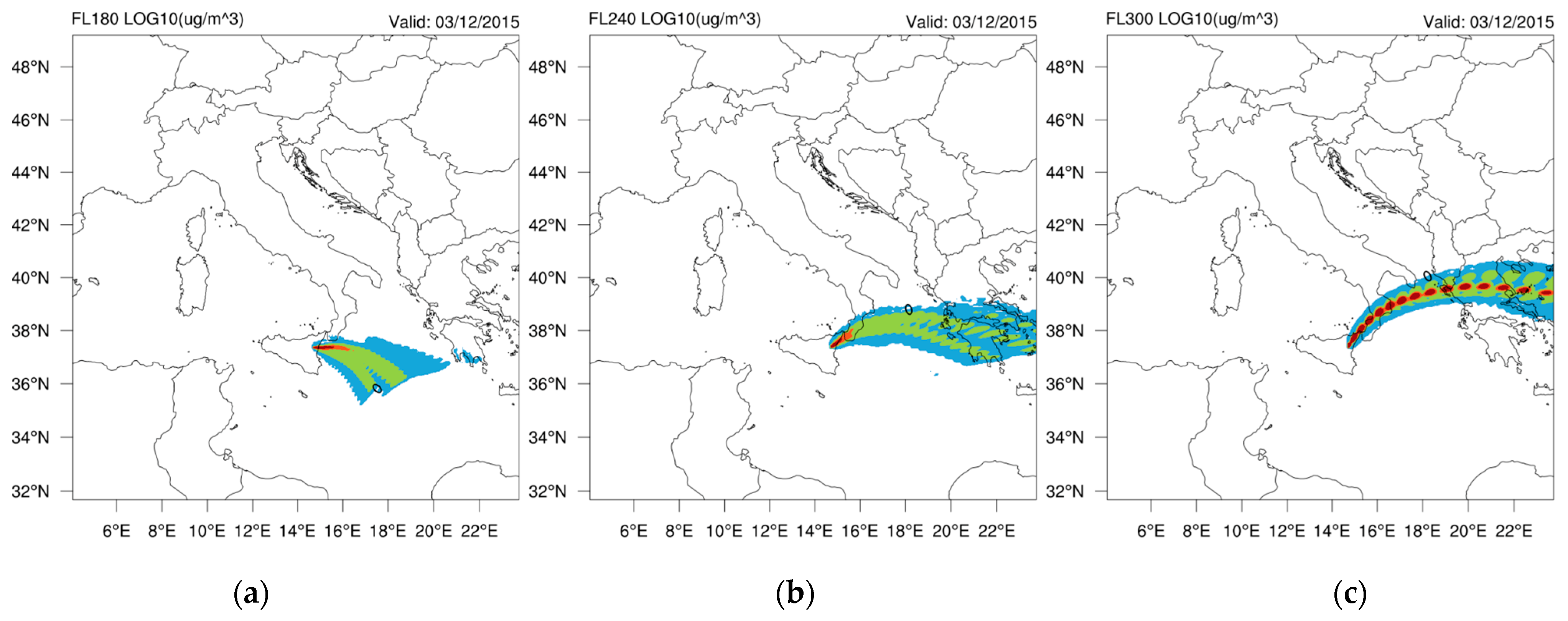

| Microphysics | (7)—4ICE Goddard scheme |
| LW/SW radiation | (5,5)—New Goddard shortwave and longwave schemes |
| Surface layer | (2)—Eta similarity scheme |
| PBL | (2)—Mellor–Yamada–Janjić scheme |
| Land surface | (4)—Noah-MP land surface model |
| Initial and boundary conditions | FNL-GFS |
| chem_opt | (300)—GOCART aerosol model |
| TGSD | E1 distribution |
| ESP | MER from V2B radar data Injection heights from Mastin et al. [35] |
| Vash_# | 1 | 2 | 3 | 4 | 5 | 6 | 7 | 8 | 9 | 10 |
|---|---|---|---|---|---|---|---|---|---|---|
| µm | 1000 2000 | 500 1000 | 250 500 | 125 250 | 62.5 125 | 31.25 62.5 | 15.625 31.25 | 7.8125 15.625 | 3.90625 7.8125 | 0 3.90625 |
| wt% | 16.7 | 8.3 | 10.4 | 12.5 | 6.4 | 12.5 | 14.6 | 8.3 | 6.2 | 4.2 |
| Sequence | Paroxysm | Date | UTC Time HH:MM |
|---|---|---|---|
| 2013 | NSE1 | 26 October | 12:00 |
| 2013 | NSE2 | 11 November | 12:00 |
| 2013 | NSE3 | 17 November | 00:00 |
| 2013 | NSE4 | 23 November | 12:00 |
| 2013 | NSE5 | 28 November | 12:00 |
| 2013 | NSE6 | 3 December | 00:00 |
| 2015 | VOR1 | 3 December | 00:00 |
| 2015 | VOR2 | 4 December | 12:00 |
| 2015 | VOR3 | 5 December | 00:00 |
| 2015 | VOR4 | 5 December | 12:00 |
| Pressure Level (hPa) | Flight Level (FL) | Height (Feet, a.s.l.) | Height (m, a.s.l.) |
|---|---|---|---|
| 300 | FL300 | 30,000 | 9200 |
| 400 | FL240 | 24,000 | 7300 |
| 500 | FL180 | 18,000 | 5500 |
| p10D Interval (μg m−3) | log10 Scale | Shading | Hazard Level |
|---|---|---|---|
| 0–200 | 0–2.2 | blue | none |
| 200–2000 | 2.2–3.3 | green | low |
| 2000–4000 | 3.3–3.6 | red | medium |
| >4000 | > 3.6 | dark red | high |
Disclaimer/Publisher’s Note: The statements, opinions and data contained in all publications are solely those of the individual author(s) and contributor(s) and not of MDPI and/or the editor(s). MDPI and/or the editor(s) disclaim responsibility for any injury to people or property resulting from any ideas, methods, instructions or products referred to in the content. |
© 2023 by the authors. Licensee MDPI, Basel, Switzerland. This article is an open access article distributed under the terms and conditions of the Creative Commons Attribution (CC BY) license (https://creativecommons.org/licenses/by/4.0/).
Share and Cite
Rizza, U.; Donnadieu, F.; Morichetti, M.; Avolio, E.; Castorina, G.; Semprebello, A.; Magazu, S.; Passerini, G.; Mancinelli, E.; Biensan, C. Airspace Contamination by Volcanic Ash from Sequences of Etna Paroxysms: Coupling the WRF-Chem Dispersion Model with Near-Source L-Band Radar Observations. Remote Sens. 2023, 15, 3760. https://doi.org/10.3390/rs15153760
Rizza U, Donnadieu F, Morichetti M, Avolio E, Castorina G, Semprebello A, Magazu S, Passerini G, Mancinelli E, Biensan C. Airspace Contamination by Volcanic Ash from Sequences of Etna Paroxysms: Coupling the WRF-Chem Dispersion Model with Near-Source L-Band Radar Observations. Remote Sensing. 2023; 15(15):3760. https://doi.org/10.3390/rs15153760
Chicago/Turabian StyleRizza, Umberto, Franck Donnadieu, Mauro Morichetti, Elenio Avolio, Giuseppe Castorina, Agostino Semprebello, Salvatore Magazu, Giorgio Passerini, Enrico Mancinelli, and Clothilde Biensan. 2023. "Airspace Contamination by Volcanic Ash from Sequences of Etna Paroxysms: Coupling the WRF-Chem Dispersion Model with Near-Source L-Band Radar Observations" Remote Sensing 15, no. 15: 3760. https://doi.org/10.3390/rs15153760
APA StyleRizza, U., Donnadieu, F., Morichetti, M., Avolio, E., Castorina, G., Semprebello, A., Magazu, S., Passerini, G., Mancinelli, E., & Biensan, C. (2023). Airspace Contamination by Volcanic Ash from Sequences of Etna Paroxysms: Coupling the WRF-Chem Dispersion Model with Near-Source L-Band Radar Observations. Remote Sensing, 15(15), 3760. https://doi.org/10.3390/rs15153760










